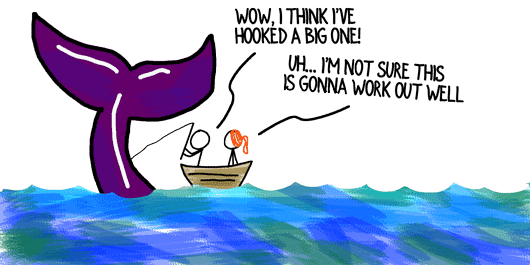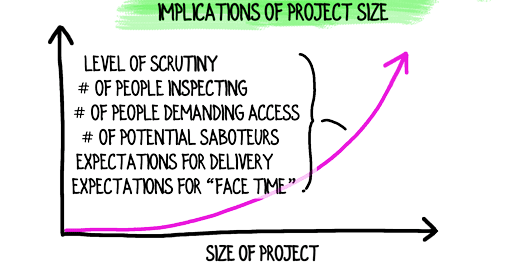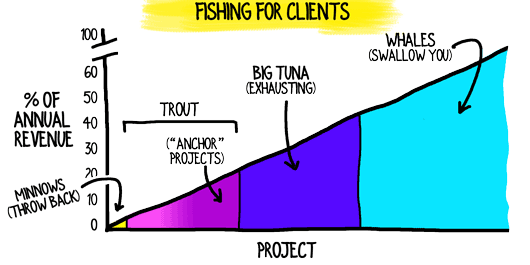Too Big? The Correct Way to Tell if a Project is Right for Your Consulting Firm
Wouldn’t it be great to land a massive, game-changing new project for your consulting firm? Maybe. However, huge assignments have equally huge downsides, and there’s a better way to grow your consulting firm.
You may have bumped up against an opportunity or two to win a whale of a project—perhaps even dethroning Deloitte or some other big name consulting firm to secure an engagement that would dwarf your typical assignments.
It’s understandable that you’d covet a mega-assignment that could instantly double your revenue and lift your consulting firm to the next level of success.
However, rather than angling for whales, you’ll build a more successful, healthier consulting firm by hauling in netfuls of trout. And if you’re already landing plenty of trout, then start reeling in salmon.
A giant project could potentially swallow your consulting firm.*
Consider some downsides:
- Higher Risk of Failure. You’re not currently built to deliver a project that is 5-10 times the size of your typical engagement. You probably don’t have the people nor the proven systems and templates required to deliver A+ work on a much larger scale. Similarly, you may not be built to handle the large leap in complexity that accompanies a mega-project.
- Elevated Client Scrutiny and Expectations. Your consulting firm is always on the line to produce top-notch results; however, the heat of the spotlight on your project flares up to an uncomfortable level when jump from, say, a $200k project to a $1m engagement. (Or from a $20k project to a $100k project.)
- Distorted Portfolio Risk. Outsized consulting projects are difficult to sustain, and if you can’t win more, your revenue can suddenly plummet by 50-90%. That’s uncomfortable, to say the least.
- Post-Project Vacuum. When your outsized project is complete, you’ll have the expensive delivery structure (e.g., systems, personnel) and/or the emotional expectations that correspond to huge projects.
Hence, be wary of assignments that would require a fundamental transformation of your consulting firm in the short term.
On the other hand, if your consulting firm is well established, then focus on upgrading to bigger, “everyday” fish (salmon vs. trout), and snagging the occasional big tuna.
(Big tuna = a project that would represent up to 40% of your total revenue.)
A big tuna stretches your consulting firm without requiring fundamental transformation. You’re compelled to upgrade your approach, processes, and capabilities. It also funds future expansion so that you can hook more big fish in the future.
Have you ever landed or turned down a whale of a project? What was the impact on your firm?
Text and images are © 2024 David A. Fields, all rights reserved.

 David A. Fields Consulting Group
David A. Fields Consulting Group 




As always good stuff David.
I take slight exception with throwing back the minnows: I’ve had a few gigs that started very small and grew up to be trout. Throw back the minnows only if they are a) not in your strategic patch, and b) aren’t likely to go anywhere.
Congrats on growing some minnows, Ian! You’ve brought up a fair consideration, and I’d suggest the following for most consulting firms:
If you have a proven path for growing very small clients into meaningful ones, or you can deliver mini projects with sublime efficiency, then don’t throw them back. And, of course, if there are other strategic reasons to take on a mini project (e.g., marquee value), then keep it.
However, for the vast majority of consulting firms, walking away from projects that are very small and saving your resources for more meaningful meals will prove a better path–instituting that rule has been one of our more reliable ways to rapidly grow a small consulting practice.
Very much appreciate the thought starter, Ian!
David, thanks for this timely (for me) post. I’m meeting with a prospect tomorrow that I feel may be a whale. I will do my diligence to determine if their needs are within my capabilities. However, if I determine that they are a whale that I would rather not hook, is there a standard and professional way to turn down such a client? I’m assuming the straight forward, honest approach is likely the best path in this instance. Thank you David!
First, good on you for having a realistic sense of your firm’s capabilities and for not taking on a client/project that could overwhelm you.
The question I have for you (and, in your shoes, I’d have for the client) is whether there’s a portion of the engagement that could be segregated off that you could handle better than, say, a one-stop shop that would take on the entire whale project. After all, if the assignment is ginormous, in all likelihood the provider will have many, many people involved and, perhaps, some subcontractors. The big firm that could win the gig is not as good as you in some area (perhaps), and if you show that you’re easy to work with–so doubling the number of suppliers isn’t a big deal– you could pick up a terrific client and a manageable client.
You posed an excellent question, Orin, and I appreciate you being willing to share your situation!
Ian – we also have had some minnows grow into larger projects – but many don’t. Like you, though we tend to keep them as long as they aren’t A or B as you note. After all, 10 minnows (~1% revenue) equal one trout (10%).
David – I understand that this is a topic that requires nuance – and we’re online, so that’s tough.
We would love to land mostly trouts (10-25% total revenue). That would fill our slate with between 4-10 projects -( with some wiggle room of course). But that number seems very small -is that typical for a small consulting firm?
Our average project is 1-2% of total revenue (environmental consulting – some regulatory, some not).
I don’t believe that we’re missing opportunities for Tuna (if a client doesn’t currently need a regulatory permit, we can’t create one – we can maintain the relationship, etc. so we’re ready when the need arrives, but that could be months or more).
That said, I can imagine an approach geared toward cultivating mostly Trout/Tuna work while eschewing minnows. Winning just a couple more than expected could be a boon, but losing a couple more than planned could be a big blow.
Historically we’ve grown incrementally, one person at a time. As large as 10 at one time, currently at 6. It seems that size is stuck in limbo where we aren’t large enough to have the inertia/gravity to carry us through a slow period, but because salary is the primary expense, we’re also too large.
We’re facing the classic problem – Should we bring someone on who is confident the work will come? or Should we land the work, then bring someone on?
We certainly don’t want to become the Deloitte equivalent, but I am struggling on seeing a path to growth to get us beyond that limbo state.
Ryan, you’re mixing a couple of different questions: what size projects are best for most firms and when should you hire staff?
To the first question: most consulting firms’ projects aren’t cookie cutter and the fees aren’t either. Hence, it’s extremely rare to find a firm that has 10 projects, each of which is 10% of the firm’s revenue. More likely is an assortment of 20-30 projects, including a couple of big tuna, a few salmon, a bunch of trout and far too many minnows.
Re the size of your firm: you may be asking the wrong question. The issue isn’t when to hire (though that is a good question), it’s why your demand isn’t steadily growing. That’s the first place I’d look.
That said, my position on hiring is very conservative. I like full-time staff to be totally utilized and swing capacity to be in constant use before adding more full-time staff. Swing capacity is where it’s at!
Great questions, Ryan. Thanks for sharing them in this forum.
Good article – whales can be vanity.
For me the best way to grow is to find clients who care about partnership – and so your sustainability becomes important for them too.
To have an honest conversation- “we’d love to take on this job, and you know it will be a big step up for us…. can we talk about the risks, and how we mitigate them together”
Pure pirate! 🏴☠️
Partnering is definitely where it’s at, Ben. We have an article coming up that emphasizes a similar point: when a good client expresses a genuine interest in your firm and you deliver extraordinary value for them, your looking at a magical partnership.
Thanks for teasing that idea and for contributing today!
Great article! The temptation to go for the big fish all the time can be enticing. But, like a ballplayer swinging for the fences with every at bat, you get a lot of strikeouts. And before long, as your batting average slips below .100, you may be told to move on. And I’ve found the minnows take about as much effort and energy as the trout or salmon, with far less payoff.
Exactly right, Bob. To butcher your metaphor: You have to run just as far to get on base when just tap a bunt as when you hit a solid line drive. Or something like that.
Adding your voice and experience to the conversation makes a difference, Bob. Thanks for posting your thoughts.
Ian, I’m sorry I jacked your thread above! I meant to start a new thread entitrely but was on a smart phone so didn’t realize what I had done.
David, thank you for posing this question:
“The question I have for you (and, in your shoes, I’d have for the client) is whether there’s a portion of the engagement that could be segregated off that you could handle better than, say, a one-stop shop that would take on the entire whale project.”
It helped me realize that it doesn’t have to be an all or nothing engagement. This may just be the best option for this specific relationship. I appreciate your feedback.
Exactly, Orin. There are more ways to look at the opportunity in front of you than you may have realized at first. Good luck with the prospect!